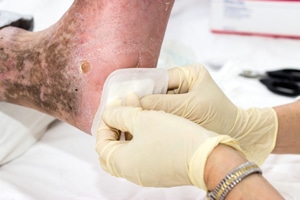
October 21, 2019
Using High Tech To Manage Diabetic Foot Complications
By Michael D. Shaw
You have heard many times about the epidemic of diabetes, and how it is no longer limited to affluent Western nations. While hyperglycemia under fasting conditions is the definitive characteristic of the disease, that is only the beginning.
Prior to the availability of inexpensive and simple blood glucose testing, utilizing small drops of blood placed on strips impregnated with glucose oxidase, diabetes was often diagnosed only after symptoms became apparent, such as…
- Increased thirst
- Frequent urination
- Extreme hunger
- Unexplained weight loss
- Fatigue
- Irritability
- Blurred vision
- Slow-healing sores
- Frequent infections, such as gums or skin infections and vaginal infections
Unfortunately, even among diabetes patients who are under a physician’s care and pharmaceutical therapy, the potential complications of diabetes are legion:
1. Cardiovascular disease. Having diabetes is a big risk factor for heart disease and stroke.
2. Neuropathy. High blood glucose can damage the capillaries feeding your nerves–especially in the legs. So-called diabetic nerve pain, numbness, or tingling usually begins at the tips of the toes or fingers and gradually spreads upward. Nerves involved with digestion and sexual performance are not exempt, and all feeling can be lost in the affected region(s) if left untreated. Blood vessel damage may be related to deficiencies in the enzyme fatty acid synthase, which interacts with nitric oxide synthase, in the cells that line blood vessel walls.
3. Kidney damage. The glomeruli can be harmed, with possible kidney failure as a result.
4. Eye damage (retinopathy). Again, blood vessel damage; in this case, to the retina, with blindness a possibility. Diabetes is also a risk factor for cataracts and glaucoma.
5. Skin problems, including bacterial and fungal infections, and many others. A number of mechanisms have been proposed to explain how diabetes makes individuals more prone to infection.
6. Hearing impairment. Hearing problems are more common in people with diabetes. Nerve and blood vessel damage are the likely culprits.
7. Alzheimer’s disease and dementia. Diabetes is a risk factor. There is also a connection between diabetes and depression.
8. Foot problems. Nerve damage and reduced blood flow in the feet can lead to a host of troubles. Limited feeling in your feet might make you unaware of injury or some object rubbing inside your shoe. Poor circulation can cause wounds to heal slowly and become infected. In the worst case, gangrene can set in, requiring amputation of a toe or even the entire foot.
Regarding foot problems, we are reminded of these unfortunate facts and figures:
- Every 20 seconds a limb is lost to diabetes.
- The lifetime risk of people with diabetes to develop a foot ulcer is 34%.
- More than 50% of diabetic foot ulcers become infected.
- 20% of diabetic foot infections result in amputation.
DFCon, the premier international diabetic foot conference, took place October 17-19. Appearing at that conference were Bert Van Hoof, Partner Group Program Manager of Azure IoT at Microsoft Corp. and Davide Vigano, CEO and Co-Founder of Sensoria Health, Inc., who spoke about the first Internet of Things + Cloud remote patient monitoring solution for diabetic patients suffering from foot ulcers.
Sensoria joined forces with Optima Molliter to develop the Motus Smart. This boot is equipped with different density interchangeable insoles to take pressure off the area of ulceration and to improve blood circulation, which is a critical factor in improving clinical outcomes. The typical progression of a foot amputation always begins with a diabetic foot ulcer. The solution is an IoT + AI (artificial intelligence) system that monitors patient adherence to clinician recommendations on movement, to expedite the healing of foot wounds and reduce risk of amputations.
According to Vigano…
“MOTUS Smart stabilizes the foot after surgery or debridement of the ulcer, monitors patient adherence and activity while offloading the weight from the area of foot ulceration. This is how MOTUS Smart improves blood circulation, reducing the time required to heal the ulcer. Clinicians can now be reimbursed for doing the right thing: They can finally monitor their diabetic patients’ foot data remotely, thanks to MOTUS Smart.”
